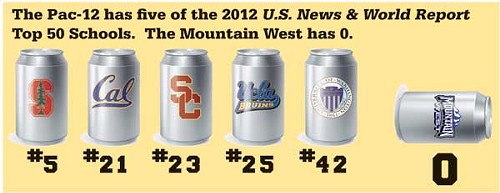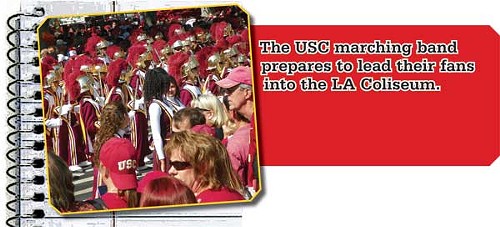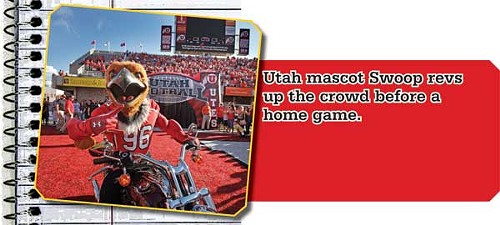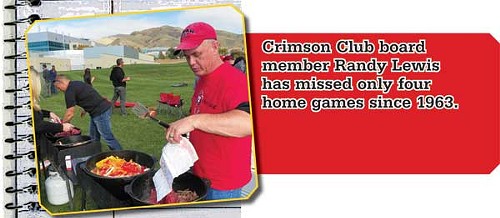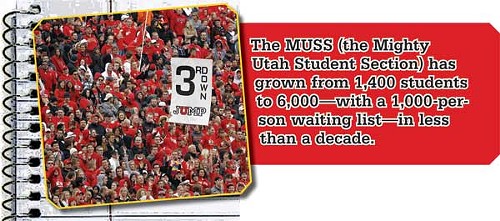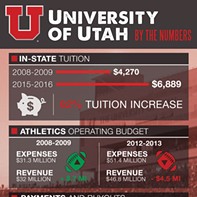Size matters.
Just look at the University of Southern California football team. Not only are the physical specimens that make up the Trojans’ roster a group of huge men; the team plays in the massive Los Angeles Memorial Coliseum, a venue that seats more than 93,000 and is historically epic as the host of the 1932 and 1984 Olympic Games.
USC looms large in the minds of college-football historians as well. The team has won 11 national championships, claimed seven Heisman Trophies for having the best player in the country, and sent hundreds of athletes on to play professionally in the National Football League.
When it comes to college football, there’s little arguing that bigger is better. Schools across the country—a legion of wannabe USCs—are navigating their way into new conference affiliations, all of them looking for a bigger and better deal for their students, faculties and athletic teams. And the deals are being driven largely by squads of 11 behemoths bashing in each other’s heads for control of a pigskin on fall Saturday afternoons.
The University of Utah is a canary in the conference-realignment coal mine; the school’s jump from the Mountain West Conference into the powerful Pac-12 is one of the more dramatic examples of upward mobility in the realignment process currently playing out in towns from Syracuse, N.Y., to College Station, Texas, to Boise, Idaho. They are the first school to move from a “small conference,” the Mountain West, into one of the six major conferences: the Pac-12, Big 12, Big Ten, Southeastern Conference, Atlantic Coast Conference and Big East.
It makes sense, then, that Utah’s inaugural Pac-12 season would start with a football game against the mighty Trojans, in that historic L.A. Coliseum, on a campus where fans of both the home team and visiting squad crowd into Heritage Hall to get a glimpse of those Heisman Trophies, where thousands gather at the Tommy Trojan statue to follow USC’s legendary marching band toward the stadium, where wandering through the Exposition Park Rose Garden can quickly make people forget they’re on a college campus, let alone at a tailgate scene.
More than 10,000 Utah fans decided the chance to watch the Sept. 10 game in person—60 minutes representing the University of Utah joining the “major leagues” of college athletics—was worth the trip to Los Angeles. For a state, and a school, after decades of feeling like outsiders and also-rans, this game meant Utah had officially arrived.
Looking around at the thousands of Utah fans dotting the Coliseum during the game, and tailgating across the Los Angeles campus alongside USC boosters for hours beforehand, it was resoundingly clear the Utes and their fans weren’t in Kansas anymore, so to speak. Or, more accurately, they weren’t in Laramie, or Fort Collins, or Provo.
The move has been a long time coming for Utah fans and alumni who have seen the east-bench campus evolve from largely a commuter school into a more traditional athletic power—with a vocal and active community of boosters—over the past decade. On game days, the U campus and Rice-Eccles Stadium fill with people from all walks of Utah life, now joined by the common cause of cheering for a football team. And while football—and its affiliated revenue—is the driving force of the U's decision to move to the Pac-12, it is far from the only reason for the mountain school to go coastal.
Movin’ On Up
When Chris Hill took over as the U’s athletic director in 1987, the school was still a part of the Western Athletic Conference, a sprawling group of smallish Western schools. Fans recall the ’80s as some dark days for Utah football, when the only guaranteed home sell-out was the BYU rivalry game. Students couldn’t be bothered to actually show up the rest of the season, despite having free access to Rice-Eccles Stadium.
Even in that environment, Hill was already thinking of bigger things, like eventually landing in the same conference as USC, Stanford and Cal-Berkeley.
“I think it took a few years in my own mind that it could be a possibility, and that it would be the right place for the next 50 years,” Hill said. “It’s been a goal of ours, pretty strongly, since the mid-’90s.”
The ’90s will be forever known to Utah fans as the heart of the Ron McBride Era, when the former coach turned a downtrodden program regularly pummeled by the LaVell Edwards-led BYU into a competitive crew that often went to bowl games and regularly beat the Cougars, even if the Utes never won an outright conference title under his watch.
In 1996, the WAC expanded from 10 teams to 16. Feeling that the conference had become unwieldy, eight of the schools—the U, BYU, UNLV, Air Force, New Mexico, Wyoming, Colorado State and San Diego State—left in 1999 to form the Mountain West.
McBride was fired after a losing season in 2002, replaced by Urban Meyer, who, in two years, led the Utes to a conference championship and then to an undefeated season in 2004, making Utah the first school from outside one of the Bowl Championship Series conferences to earn a spot in one of the BCS bowl games—a major windfall both money-wise and attention-wise. Meyer left for a job at Florida, but current coach Kyle Whittingham kept up the winning ways in the Mountain West, leading another BCS-busting campaign in 2008, ending the perfect season with a win against Southeastern Conference power Alabama in New Orleans’ Sugar Bowl.
Given the success of Utah’s football team under Meyer and Whittingham, a move to a conference affiliated with the BCS—with automatic access to a BCS bowl game and the money that comes with it—became No. 1 on every Utah booster’s wish list. And when an invitation came on June 17, 2010 to join the Pac-10 and create the Pac-12 with fellow conference-shifter Colorado, it was an easy decision.
“I’m kind of a dreamer, and what we knew was that what we did to be successful in the WAC and Mountain West is what we need to do to be successful in the Pac-12,” Hill said. “It doesn’t change. You have to put together great coaches, great student-athletes, great facilities. You gotta win. And the advantage that we also have is a great university that’s a Research I institution that’s growing, that’s more prestigious, that’s nationally known. You put that together, and it puts us in a common place with the Pac-12 schools.”
Ka-Ching!
It will actually be a little while before the University of Utah has much in common with its new conference rivals, financially speaking. The school joins the Pac-12 fray with the smallest athletic-department budget in the league. But at face value, joining the Pac-12 is most definitely an economic windfall for the U.
Consider this: As the Bowl Championship Series is currently set up, the five BCS bowl games—the Rose Bowl, Fiesta Bowl, Sugar Bowl, Orange Bowl and the national championship game—generate $142.5 million from TV revenue and ticket sales, according to David Rudd, one of the U’s authorities on the move to the Pac-12 and the dean of the College of Social & Behavioral Science.
Of that $142.5 million, $124.5 is divvied up among the six BCS conferences. The remaining $24 million or so is left to be divided by smaller conferences like the Mountain West.
The Pac-12 TV deal is even more significant, even though Utah will only get partial payouts until the 2014 season. The league’s 12-year TV deal with ESPN and Fox is worth a reported $3 billion, which breaks down to about $250 million a year for the conference, or $21 million or so per year for each school come 2014. Compare that to the roughly $1.2 million the school got under the Mountain West’s broadcast deal, and it’s not hard to see why Utah jumped at the chance to run toward the Pacific Ocean powers.
The irony, though, is that while the school will receive an influx of money not imaginable in its Mountain West days, the U will have to greatly increase how much money it spends to be competitive with the bigger schools in the Pac-12. Facilities will need to be upgraded—the U’s football stadium is second-smallest in the league, and will likely have to be expanded at some point—and new varsity teams might be created in the future to compete in, say, lacrosse or men’s volleyball. Those new sports’ formations come at a cost of $500,000 to $1 million per sport, according to Hill, and the school is required to keep gender equity in what is offered, so the costs add up quickly. New fundraising efforts across the board—for research and academics, new and improved campus buildings and infrastructure, and the athletic department—will be part of the program for the indefinite future.
That includes dinging students and fans—not just big-money alumni—for more cash. Football season-ticket holders noticed a significant jump in ticket prices—most by 20 percent over the cost during the final Mountain West year in 2010—but few balked at the increase; more than 98 percent of 2010 season-ticket holders renewed for the inaugural Pac-12 season.
Student fees for athletics jumped, as well, with the school approving a nearly 8 percent increase for this academic year, from roughly $150 to $162. And students can probably expect to keep paying more in fees and tuition, despite a recent legislative audit that showed the U does a poor job accounting for $27.4 million in student fees collected each year. According to a Salt Lake Tribune story on the audit, U student fees have jumped 69 percent in the past decade to $912 per year for a full-time student, roughly $162 of which is dedicated to supporting athletic programs. Tuition has doubled in the same time period—another upward spiral unlikely to change any time soon.
It’s Academic, Watson
While most focus on football when they consider the U’s move to the Pac-12, Rudd has been preaching the academic benefits for the school for months, via a handy PowerPoint presentation.
At a recent lunch discussion at the campus’ Alumni House, the Princeton grad showed how the change of conferences—admittedly football-driven—can benefit the school in other areas, starting with attracting potential students who wouldn’t have thought of applying to the U.
“When you look at the shift from the Mountain West to the Pac-12, the focus of the exposure is enormous,” Rudd said. “The immediate shift in the brand is significant, and it’s experienced in many different ways across the university.”
As unsavory as it might be to think of a school as a “brand,” Rudd said, make no mistake about it: Students are “very much consumers of higher education. They’re paying to get an experience, and that experience is a very broad experience.”
In other words, while a student might look at a particular academic discipline as the most important reason to pick a school—whether in computer science or ballet—they also look at what other kinds of experiences they’ll be able to take advantage of outside the classroom. And the environment created by a big-time athletic department goes a long way toward attracting applicants, even those who don’t care about sports.
“Where do we rally around things and where do we tailgate [on a college campus]?” Rudd asked, rhetorically. “At athletic events.”
Even the Ivy League, a group of schools recognized as some of the best in the world, Rudd notes, is based around sports. The Ivy League is an athletic affiliation, no more and no less, yet the conference has managed to build a “brand” based on academics at Harvard, Yale, et al., rather than on its forgettable football teams.
Rudd compares the U’s move to Penn State University’s change in 1990 from being an athletic independent to being a member of the Big Ten conference. When Penn State made the switch, the school’s graduation rate was 57 percent, roughly what Utah’s grad rate was in 2010, and by 2009, PSU’s had increased to 85 percent. The amount of research activity at Penn State likewise rose, from about $380 million in 1990 to $780 million in 2009. Rudd attributes that rise to the greater competition encountered by joining the research-heavy Big Ten.
When it comes to research activity, the U finds itself in a similar position entering its new conference. The average Pac-12 research budget in 2009 was $454 million, while the average for the Mountain West was $106 million. Utah’s $451 million or so made it tops in the Mountain West, but lands it firmly in the middle of the pack in the Pac-12, where schools like Stanford, UCLA and the University of Washington regularly do more than $1 billion annually in research activity.
Rudd contends that as the U strives to keep up with its Pac-12 peers, it will see rises across the board in fundraising, student applicants, faculty and staff pay and academic prestige.
“The larger the average research budget, the more likely you are to have an academic impact, so the more likely you are to be ranked highly and recognized nationally,” Rudd said. “And the more likely you are to get a higher number of student applicants, the greater the performance of your students and the greater the impact of the university from an academic perspective.”
While it’s natural to assume that as the U’s academic reputation increases, tuition will as well, Rudd believes those increases will be offset by more financial aid. Even though the U’s graduation rate sits at 57 percent, that number is skewed because “80 percent of our students work 20 hours or more a week.”
“The competitiveness of the national application pool increases, but there will also be greater resources for students, so they’ll have to work less,” Rudd said, noting that the Pac-12 move should increase the number of scholarships and grants available, thanks to better endowment support.
Kenneth Morley, a 21-year-old senior in atmospheric sciences, believes the move to the Pac-12 will make his degree more valuable, saying that he had “a lot of pride in [Utah] being able to be accepted in such a prestigious group.”
“And if tuition goes up and it’s harder to get in, that’s a good thing”—making his eventual degree that much more meaningful, Morley said.
A Bumpy Entry
The sunny financial and academic hopes of the Pac-12 move are long-term predictions that will take years to prove true or false. The immediate reality of joining the “big boys,” athletically speaking, came clear just a few games into the season this fall.
After an up-and-down first few games, including an exciting, close loss in the USC Pac-12 opener and a blowout win against in-state rival BYU, Utah’s starting quarterback Jordan Wynn was lost for the season with a shoulder injury in the team’s Pac-12 home opener against Washington.
The Washington game was met with much hoopla, a visit from Pac-12 commissioner Larry Scott and a downtown Salt Lake City pep rally featuring Hill alongside Mayor Ralph Becker and the Downtown Alliance’s Jason Mathis. But a huge loss and the sudden lack of an experienced quarterback offered a vivid reminder that Utah’s program, successful as it’s been, is not as loaded with the same brand of top-to-bottom talent as much of the school’s Pac-12 peers. Utah lost its first four games against Pac-12 foes before beating Oregon State, in late October.
“Football has been very, very successful, and we’ve struggled some this year,” Hill said. “There are some things we’re struggling for that we haven’t had to before. Nobody’s looking for excuses.
“One of the things we have here is, we’re not afraid of high competition,” Hill continues. “We always say ‘high risk is high reward, and low risk is low reward.’ This way, we get to take a swing at the very best in the country.”
Bill Riley—who does play-by-play radio coverage of Utah games for ESPN 700 AM and hosts a daily show on the station—has noticed changing expectations among fans. Many figured at the season’s start that the team would be one of the conference’s best. Instead, Utah needed a season-ending hot streak to save a season that looked like a disaster at the halfway point. Heading into this weekend, there’s a slight chance the team could land in the first Pac-12 championship game with a 5-4 league record, 8-4 overall.
“I didn’t have the expectation that Utah was going to come in on the same footing as the best of the Pac-12,” Riley said. “The talent, the first-line and second-line talent, is on par. But I never thought they’d go into the conference and be among the elite. Those programs [like USC, Stanford], there’s a reason they’ve been among the Top 5 and Top 10 [in the country] consistently for the last three, four, five years.”
Dan Sorensen is the managing editor of UteZone.com, an affiliate of athletic-recruiting supersite Rivals.com and home to a passion-filled message board where Ute fans pay a yearly subscription to congregate and argue over the minutiae of Utah athletics. And while Sorensen grew up in Utah, the 35-year-old public-relations specialist with degrees from Utah State and Westminster College tends to UteZone.com from his home in San Francisco, in the dead center of Pac-12 country.
Sorensen could sense the excitement of the Utah online community as this season approached, calling the feeling one of “unbridled optimism. People were so happy to be part of the club.” A couple months later, Sorensen notes, and “Utah fans have been forced to learn a couple of harsh lessons” about the bigger, faster athletes in the new conference.
Those lessons haven’t been enough to cause the Ute faithful to, well, lose faith. Indeed, in talking to everyone from students to townie fans, administrators to alumni, none regretted the jump to the Pac-12.
Randy Lewis—a board member of the school’s Crimson Club boosters group and weekly cheerleader, literally, at his tailgating spot—has missed only four Utah home games since 1963. He and his wife, Tammy, travel to nearly every road game, too, and donate considerable time and money to the Utah athletic department. Lewis laughs at the notion that maybe Utah fans will miss being the big fish in the small pond of the old Mountain West.
“It’s been a struggle; the competition is great,” Lewis said of the change. “It’s about what I expected. But how about San Francisco instead of Laramie? The Coliseum in L.A. instead of Fort Collins? Or Tucson in November instead of Fort Collins? We all want to do well. We all want it to be 2004 and 2008 all over again, and it’s not going to be. But the idea of going to Cal and these other schools, instead of where we were going, it’s a huge difference.”
Left Behind
Perhaps no sport makes a bigger deal of tradition and history as college football does. And as hard as it is to find anyone yearning for the good ol’ days of life in the Mountain West, there’s something to be said for rivals left behind.
The old conference, with the exception of San Diego State, consisted of schools in towns and cities across a vast, mysterious and harsh swath of America that mixes soaring peaks and stunning deserts in the Mountain time zone. Towns like Laramie, Wyo., and Fort Collins, Colo., have some charm for fans more interested in the country’s blue highways than big-city tourism. And having Las Vegas as a playground for UNLV games and the conference basketball tournament just six hours away was pretty good for Utah fans.
“I’ve always said we have good friends in that league, but every one of those people have been fully gracious with us, fully understand why we made the move we did,” Hill said. “There’s nothing but fond memories, except for a few games we lost. But to be honest, the transition and being in the Pac-12, you don’t really think about the past.”
One part of the past that’s not going away is the annual rivalry game against BYU, aka the Holy War. The football series goes back to 1896, and annual showdowns were assured by the teams being in the same conference from 1922 to 2010. With Utah now in the Pac-12 and BYU leaving the Mountain West to go independent, the schools will have to negotiate games as non-conference foes; both schools have publicly expressed a desire to do so.
In 2011, for the first time in recent memory, the Holy War game was played in mid-September instead of the end of November as the season finale. And the lack of excitement on both sides in the week leading up to the game led one to believe neither Utah nor BYU’s fans knew quite what to make of a warm, sunny Holy War with no ramifications beyond bragging rights over a rival. Riley noticed the difference from past rivalry games from inside his radio studio.
“It didn’t feel like a Utah/BYU week to me at all,” Riley said. “It felt like kind of a big game, but it didn’t feel like Utah/BYU … I don’t think it will ever be like it was when they were in the same conference and were playing the last game of the year, but I think they could create some of that magic and hype if they played it the first game of the year.”
Hill said the change might be for the good, taking some of the steam out of the uglier elements of the rivalry.
“It’s always going to remain intense, but it’s going to be at the beginning of the year and we’d all be na've if we didn’t know that was going to change the feel,” Hill said. “One of the things I’m hoping is, it takes some of the toxic nature out of the fans’ interest in the game. For us, it’s probably a little healthier. But it’s going to be different, no question.”
Hill might be underestimating the yearlong, nay, lifelong disdain of Utah and BYU fans toward their rivals, but part of being an athletic director is being a diplomat.
Morley has no desire to revisit Utah’s successful years in the Mountain West, even though games against the University of New Mexico gave him an easy excuse to visit his Albuquerque hometown.
When he talks to his high school friends who attend New Mexico, he recognizes the dramatic differences in college experiences between him and them, something he attributes to becoming a fanatical Utah football fan when he arrived in Salt Lake City four years ago and joined the MUSS, the so-called “Mighty Utah Student Section” that’s grown from 1,400 students during Urban Meyer’s first year to 6,000 in 2011, with 1,000 on a waiting list for tickets in the MUSS section at home football games.
“New Mexico fans, basically, they don’t care about football at all,” Morley said of his friends. “They all go to the tailgate and eat and drink and socialize, and then they don’t go to the game.”
Sounds a lot like Utah football during the late ’80s and early ’90s. And Morley sounds a lot like the kind of student that the Pac-12 branding Rudd talked about will attract, using football as a gateway to Utah’s various programs.
“One of the reasons I want to go to grad school at the U is because of the MUSS and football,” Morley said. “I want to get my Ph.D. here. I want to be in the Crimson Club someday.”
That’s music to the ears of the U administrators who led the charge to the Pac-12.%uFFFD
More by Dan Nailen
-
Too High to Die
Youthful indiscretion leads to a lifelong obsession with the Meat Puppets.
- Mar 22, 2017
-
Life-Changing Experience
Hendrix tribute brings Jimi's old bass player and amazing cast of guitarists to Utah.
- Mar 1, 2017
-
Him Again
Howard Jones is an '80s icon, Utah stalker and a one-man gateway to synth-pop's glories.
- Jul 6, 2016
- More »
Latest in Cover Story
Readers also liked…
-
Forget the family pedigree—Robert F. Kennedy Jr should not be the next president of the United States
Trojan Horse
- Jun 21, 2023
-
Women decry harassment and toxic culture at St. George auto dealership
Men at Work
- Oct 11, 2023



